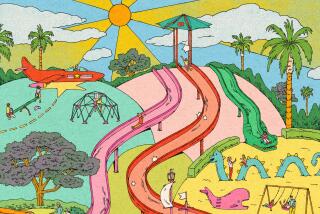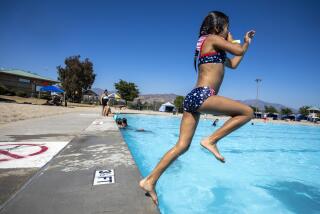Warning Issued on Playground Risks
- Share via
Most playgrounds in Los Angeles County and across the nation pose hidden risks that could seriously injure or even kill young children, two consumer organizations said Thursday.
Children’s play equipment often rises too high off the ground, is installed too close together or is surrounded by hard landing areas that make play more dangerous than it should be, said a report released by the California Public Interest Research Group (CALPIRG) and the Consumer Federation of America.
“Public playgrounds can be wonderful places for children to have fun and face new challenges,” CALPIRG’s Pam Pressley told reporters at Santa Monica’s Clover Park. “But far too many playgrounds contain hidden hazards that can injure and even kill.”
Pressley urged parents and community activists to identify hazards at their parks and demand that officials repair or remove them.
The organizations are also pressuring state health officials to complete regulations for playground equipment--rules ordered by a 1991 law but never implemented, Pressley said.
In the four years since the consumer groups first surveyed playgrounds, some improvements have been made--particularly the replacement of concrete and asphalt playing areas with more forgiving materials and the replacement of hard metal and wood swings in favor of plastic and rubber ones.
The consumer groups surveyed 58 playgrounds in California and 562 nationally. They concluded that many of the approximately 15 deaths and 150,000 injuries requiring emergency medical attention each year could be prevented by removing the hazards.
The survey found that:
* Nine of 10 playgrounds in California have dangerously hard surfaces around swings, slides and jungle gyms. The organizations recommend a 9-inch-deep bed of sand, wood chips or other soft material. Most play areas have less padding, or none at all.
* Three of five have equipment that can trap young heads.
* About a third of swings are placed too close together, or too close to their own support bars or other equipment.
* Seven of 10 playgrounds have equipment that can catch or snag drawstrings on children’s clothing and loose garments--creating the potential for serious injuries or strangulation.
* Many jungle gyms and climbing toys stand more than the recommended six feet tall for school-age children and four feet for preschool children.
Six Los Angeles parks and three in Santa Monica were included in the survey. Officials in those cities could not be reached for comment on deficiencies cited in the report.
While improvements in facilities are always possible, park officials in other cities said there is no substitute for adult supervision on playgrounds.
Children can fall from even the safest equipment, they said. Only parents or caretakers can prevent children from wearing loose clothing that might snag and contribute to injuries.
“I think that both the city and the parents of the children have responsibilities,” said Patricia Vargas, whose 6-year-old, Antonio, played at Lafayette Park west of downtown Los Angeles on Thursday. “It’s up to the city to maintain a safe, clean playground for children. I think that the parents have a responsibility, too. . . . They have to look at what is safe for their kids to play on.”
Other parents at Lafayette and nearby MacArthur Park voiced some of the same concerns as the consumer groups.
“There are no belts for the little children who want to swing,” said Anna Orellana, a Los Angeles mother of three. “Last week I saw a man bring his own belt to keep his daughter on the swing.”
(BEGIN TEXT OF INFOBOX / INFOGRAPHIC)
Safety Checklist
The Consumer Federation of America advises parents to survey playgrounds for hazards that could cause injury or death. Here are some questions that can be used to help evaluate safety at your local playground.
* Is there a lack of protective surfacing on or around play equipment?
The group says 9 to 12 inches of loose fill materials such as hardwood chips and sand is acceptable.
* Are the pieces of play equipment too close together?
Generally, there should be at least six feet in all directions between pieces of equipment.
* Is the equipment too high above the ground?
The highest rungs and platforms should not exceed six feet above protective surfacing for school-age children or four feet for preschool children.
* Does the equipment have any entanglement hazards on which children may catch clothing or anything else around the neck?
Look for open S hooks, especially on swings, and gaps, holes or other protrusions that could act as catch points.
Source: Consumer Federation of America
*
Times correspondent John M. Gonzales contributed to this story.
More to Read
Sign up for Essential California
The most important California stories and recommendations in your inbox every morning.
You may occasionally receive promotional content from the Los Angeles Times.













